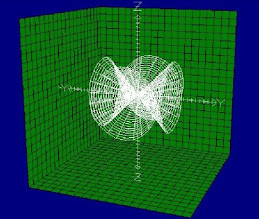Fundamental particles are the building blocks of nature, of which the photon and the electron have the most visible impact on our everyday life. Photons are all pervasive. If they have the right energy, they can stimulate your eyes' photoreceptor cells. At other energies they will warm you up because they radiate from a warm object. Electrons are more energetic than the photons. They can either be free in space, or bound in atoms. Through their motion, they transmit motion to photons, which in turn can excite other electrons at distant places. This phenomenon, known as electromagnetism, is used in all wireless transmissions. Photons are the electromagnetic force carriers and electrons are the electromagnetic force sources.
In order to understand the behavior of photons and electrons, it is important to have analogies that help us keeping track of them. In previous posts, I mentioned some helpful analogies for photons (for example at this post on polarization). Although electrons also show wave behavior, they act a bit differently from photons. You can not stack electrons near to one another, except if they have compatible spinning motions. For spinning motions to be compatible means that the electrons must:
- either spin at rates whose proportions are expressed with integers: for example one electron spins twice as fast as the other electron,
- or spin in different directions, if they spin with the same velocity.
 I sometimes come across situations that remind me of electrons. If you're standing in the bus or in the metro, you grip a pole to keep equilibrium. In the metro-train in my Paris suburb, the poles occur in pairs, like in the picture aside. When my children were younger, one of their favorite games was to spin around those poles. For parents, if you let your kids spin around the poles disorderedly, this game can be quite stressful, ending with fighting or crying. I used to explain to them that they had to spin like electrons in atoms. If one kid spins in one direction, the other kid needs to spin in opposite direction, in order to avoid hard clashes. I recently asked them if they could do it again so that I could put it on movie and post it to illustrate this electron analogy. But they've grown up and are now ashamed to play such games:-) So I decided to create the following simple animations that illustrate the electron spin and the Pauli exclusion principle.
I sometimes come across situations that remind me of electrons. If you're standing in the bus or in the metro, you grip a pole to keep equilibrium. In the metro-train in my Paris suburb, the poles occur in pairs, like in the picture aside. When my children were younger, one of their favorite games was to spin around those poles. For parents, if you let your kids spin around the poles disorderedly, this game can be quite stressful, ending with fighting or crying. I used to explain to them that they had to spin like electrons in atoms. If one kid spins in one direction, the other kid needs to spin in opposite direction, in order to avoid hard clashes. I recently asked them if they could do it again so that I could put it on movie and post it to illustrate this electron analogy. But they've grown up and are now ashamed to play such games:-) So I decided to create the following simple animations that illustrate the electron spin and the Pauli exclusion principle. A kid spinning around the pole is alike an electron spinning around a proton in its state of minimum energy, see Figure 1. Physicists designate the spinning direction with the help of the right hand rule. The kid of Figure 1 therefore has its spin down.
A kid spinning around the pole is alike an electron spinning around a proton in its state of minimum energy, see Figure 1. Physicists designate the spinning direction with the help of the right hand rule. The kid of Figure 1 therefore has its spin down.If your second kid spins in the same direction around the other pole, you can be sure that this game won't last for long. Their motions are incompatible and it ends up with a clash, see Figure 2.

If you want them to play peacefully, you need to instruct them to follow a natural rule: the Pauli exclusion principle, illustrated in Figure 3. Electrons with same spinning velocity and sharing the same space can only occur if their spins are opposite. Very useful rule to keep harmony in the family!









